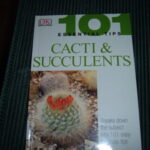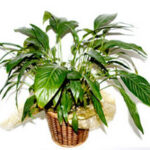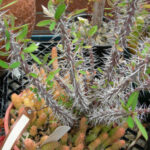The scientific name for the cactus family is Cactaceae. The Cactaceae are mostly spiny succulents with photosynthetic stems that comprise slightly more than 100 genera and 1500 to 1800 species (Neffeler 2002). A succulent is a plant that stores water for times when water is scarce. They are usually found in arid environments like deserts or semi-desert areas. They can also live in areas of extreme but not reliable rainfall (like when it only rains once or twice a year in quick bursts). Cacti are among the most conspicuous and characteristic plants of warm and arid areas of the New World (Nyffeler 2002). The cactus family is entirely American in origin. Most cacti species occur on the ground while few can be found in the leaves of trees in tropical rain forests (Zomlefer 1994). Centers of diversity include the arid regions of North and South America, notably the southwestern United States and Mexico, East Brazil, and the eastern and western slopes of the South American Andes (Nyffeler 2002.) Others can occur in the East and middle-West of the U.S. The northern limits of the cacti include Washington, Minnesota, Wisconsin, Massachusetts and even the Canadian provinces of British Colombia, Alberta, and Ontario while they range southward to the previously mentioned areas of South America (Benson 1969). In the U.S., cacti are most abundant in Arizona, Texas, and in parts of southern California and New Mexico (Bowers, Burgess, & Turner 1995). The most outstanding cactus species in scenic appeal is the gigantic sequaro (Carnegia gigantea), considered the largest succulent in the U.S. (Kearny, Peebles 1969).
A sequaro age-height relationship applicable to multiple populations has never been established, however, they do live upwards of 200 years. They do not put on annual rings, so researchers rely on height and growth to estimate age (Drezner 2003). Although cacti are mainly in North and South America, one singly epiphytic species, Rhipsalis baccifera, has a distribution range that naturally extends beyond the New World to Southern Africa, Madagascar, and Sri Lanka (Campbell, Judd, Kellog 2002; Nyffeler 2002). There are stem, root and leaf succulents. Stem succulents store water in the stem of the plant. Root succulents store water in the roots or a caudex. A caudex is a storage organ in some root succulents that grows below or at ground level. It grows in size as the cactus grows older. Examples of root succulent cacti would include: Peniocereus greggii (queen of the night), and the Adeniums and Pachypodiums (Madagascar palm). The leaf succulant plants store water in their moist, fluid filled leaves. By no means are the plants of the Cactaceae the only plants with these arid adaptations of succulent parts. Agavaceae, Euphorbiaceae, and Aizoaceae, are just a few of the many more families that possess succulent features.
The plants of the cactus family are succulent herbs to small trees. They have enlarged stems that are mostly tuberculated, ribbed and/or jointed. They have a very simple, superficial root structure (Zomlefer 1994), relying on low xylem pressure for a larger driving force for water uptake from the soil (Linton 1999). Leaves are usually absent in most species, although they possess specialized axillary buds called areoles that bear spines and sometimes bristles called glochids (Zomlefer 1994). The most distinctive feature of the cactus family is the presence of spines and areoles (Benson 1969). The spines of the cacti are produced in clusters at regular intervals on the stem, in the positions normal for buds, just above the usual positions of leaves though only visible in a few cacti (Benson 1982). The spines of a cactus are leaves modified to protect the fleshy stem from animal consumption (Mader 1998). The flowers of the cacti are solitary with integrated sepals and petals with an inferior ovary sunken into the stem. Fruits are usually spiny or bristly (Zomlefer 1994). The breeding system for the Cactaceae includes outcrossing, self-compatibility, agamospermy, dioecy, trioecy, and gynodiocy (Strittmatter 2002). Their anatomical features consist of parenchymatous tissues, commonly occupying scattered mucilage cells and calcium oxalate crystals. The sieve tubes have a special kind of P-type plastid while the stem possesses several adaptations related to water storage and retention (Zomlefer 1994). Water deficit stimulates root initiation in most species. In many species, during dry conditions, the total number lateral root primordia increased 2.9 times compared to moist conditions (Dubrovsky 2003). Basically the cactus family is characterized by three unique morphological features: short shoots modified into areoles, shoot apical meristems that are organized into four specific zones, and ovaries that are sunken into the receptacles and covered by bracts and areoles (Nyffeler 2002).
Due to their highly modified morphology, taxonomists generally regarded the cacti as a very distinct group and placed it in its own order, Cactales. However, there was a disagreement about its closest relatives until studies of embryology, plant pigment chemistry, and sieve-element plastids suggested a close relationship of the family Cactaceae to the core Caryophyllales (Nyffeler 2002). Molecular systematic studies have substantially increased our knowledge of the phylogony of the Caryophyllales (Cuenoud et. al. 2002). Further molecular studies confirmed this inference and have identified a distinct clade consisting of Portulaceae, Basellaceae, Cactaceae, and Didieraceae. Cactaceae is generally classified into three subfamilies: Pereskioideae, Opuntioideae, and Cactoideae. By far the most diverse and species-rich of these subfamilies, comprising greater than 80% of the species, is Cactoideae (Neffeler 2002).
All of the numbers to be given of genera and species are calculated estimations of the different numbers given in the most recent sources that have been obtained in this research. There are approximately 100 genera of Cactaceae. Of these 100, there are only 4 that are considered major: Opuntia, Mammillaria, Cleistocactus, and Echinopsis (Zomlefer 1994).
According to most of my references, Opuntia is the genus containing the most species, however, Mammillaria, is a close rival. There are an estimated 220 known species of Opuntia. They vary greatly in geographic distribution, spanning the globe from southern Canada to southern South America, the Galapogos Archipelago, the West Indies, and many other American islands (Gibson and Nobel 1986). Some species of Opuntia are known to possess small, subulate, early cadacous leaves. The species pictured above is Opuntia humifusa, or commonly known as a prickly-pear cactus. This particular species can be found in 39 of the 50 states and in Mexico. The prickly-pear cactus flourishes in arid areas where many other types of vegetation are lacking. It also inhabits seabeach and other sand dune communities, as well as being a prominent species of prairie habitat. The seeds are oval shaped, smooth and flattened on the sides with a size of about 3 – 5 mm. long (Bell and Radford 1964). There is evidence for the use of Opuntia as human food at least 9000 years ago and possibly as early as 12,000 years ago (Griffith 2004). Species of the Opuntia have been used in numerous ways: first and foremost, many species of Opuntia are grown for the large, sweet fruits (sometimes called “tunas”) which are sometimes available in local and commercial markets worldwide. Important “tuna” growing areas include Mexico, Sicily, Algeria, Chile, Brazil, and Northern Africa. Second are the cladodes (stem segments) harvested as a vegetable crop. Medicinal properties have been documented as far back as 1552, and were mostly used in this way by Native Americans. Opuntia has also been grown from pre-Colombian times as a host plant for cochineal insects (Dactylopius coccus) for the production red and purple dyes (Griffith 2004).
Mammillaria is the genera closest to Opuntia in numbers of species. There are about 150 known Mammillaria. Members of this genus are low-growing, globular cacti with distinctly tuberculate stem morphology. Plants may either be solitary or form massive mounds. All species possess dimorphic areoles. The vegetative (spine bearing) areole is borne on the tubercle apex, while the flowering areoles are located in the axis of the tubercles (Butterworth 2004). The flowers are as long as broad with distinct wooly or bristly areoles at their base. The tube is a funnel-shape. The fruit has a clavate to globose shape with a greenish to scarlet coloration (Jepson 1953). Succulent berries are exerted in the ovary, often hidden within the base of the tubercles. It has yellowish-brown to black crustaceous seeds. These plants are covered with cylindrical, ovoid, or cone-shaped spiny tubercles (Fernald 1970).
Echinopsis is a small cylindrical plant with well developed ribs. Most species of Echinopsis grow in thick clumps. Each stem has its own roots. Some species are solitary and cylindrical or nearly globose (Gibson 1986). They possess areoles that are usually circular, born on the ribs and felted. The flowers are spiny arising from old areoles and are mostly white yet rarely yellow or rose colored (Britton and Rose 1963).
Cleistocactus is the fourth most popular genus noted as being slender, erect or clambering cacti with numerous low ribs and approximate areoles. The flowers are slender and tubular with a withering-resistant parianth on the fruit. It has small perianth segments that can be red or green. The stamens and style are excerted. The ovary and flower tubes have many appressed scales bearing long hairs or wool inn their axils. The fruit is small, globular, and highly colored becoming naked with white pulp and black seeds. The majority of Cleistocactus species are found in South America (Britton and Rose 1963).
The leaves of the Cactaceae are always alternate. Sometimes the leaves will be extremely reduced or not exist at all. Rarely these leaves will be well developed and fleshy. The leaves have highly modified axillary buds or shoots called areoles. Sometimes the leaves are large and persistent to undeveloped and scale-like. These axillary buds (or branches) are formed into cushion-like areas called areoles bearing bristles or spine clusters (Zomlefer 1994).
The flowers in the Cactaceae are sessile (lacking a basal stalk, or peduncle) and solitary. They derive upon or near the areoles producing only one flower per areole. They are actinomorphic (radially symmetrical) to sometimes slightly zygomorphic (bilaterally symmetrical). The flowers and fruits house the reproductive structures. The stamens (male structures) and the perianth parts (sepals and petals) arise from the base of the ovary forming a tube or cup called a hypanthium (Zomlefer. 1994). The flowers come in many lengths, shapes, and colors. Each construction attracts different types of animal pollinators such as bees, birds, bats, and nocturnal moths (Lichtenzveig 2000). Take hummingbirds for example; many species of cacti from Mexico and Peru have long, narrow, tubular, red flowers that open in the morning hours. The hummingbirds are attracted to the red flowers. Hovering at the flower, it will insert its long bill to extract the nectar at the base of the floral tube. These flowers have evolved this way to specifically fit the bird’s feeding strategy. It is also specialized enough to exclude organisms that cannot fit in the narrow tube, not attracted to red, and are only active in the night (Gibson and Nobel 1986).
The fruit is a berry. It is often spiny or bristly with many seeds that are immersed in pulp. Perisperm can be absent or sometimes abundant. The embryos in these fruits are usually curved (Zomlefer. 1994). Another interesting example (more geared towards the fruits than the flowers) comes from the recent studies of the senita moth (Upiga virescens). Instead of being visited by bird or bats, columnar cacti from the genus Lophocereus (also given the common name senita) are night-pollinated by the senita moth. Each stage in the life cycle of U. virescens is ultimately associated with the host plant. Adult senita moths rest during the day in the elongated, bristle-like spines characteristic of reproductively mature senita stems. Female moths actively pollinate and ovipost on the nocturnal white to pink flowers. The larvae feed within the developing fruit and tunnel into the stem to pupate before the damaged fruit abscise from the cactus. The senita moth is thus both a pollinator and a seed consumer, much like yukka moths and fig wasps are with there particular hosts (Hartmann et.al. 2002). This is similar to the way the fruits of the Opuntia have been used for cultivation of certain insects used in the production of red and purple dyes.
Another notable importance of the cultivation of cactus fruits is artificial selection. Ethnobotanical and morphological studies found that artificial selection is directed to favor individuals producing large fruits, sweet pulp with colors other than red, and thin peel with few areoles. Artificial selection is carried out mostly by keeping and enhancing through vegetative propagation the desirable phenotypes and by eliminating the undesirable ones. This seems to be the main process that maintains and develops the morphological divergence between wild and cultivated populations of cacti (Casas et.al. 1999).
Many economic uses and products can be derived from the cactus family. We use timber from several species of Cephalocerus and Pereskia. Medicine and ritual drugs come from some genera such as Lophophora, which is what peyote is from. This hallucinogenic drug (also known as mescal-button) contains concentrations of mescaline, a narcotic alkaloid. These days peyote is only legal for the ritualistic use of certain Indian tribes who use it for religious ceremonies. Fruits from the Opuntia and several other genera are edible and have nutritional value. Artificial selection has also been an important factor in the cultivation of fruits and products produced by the mutualistic relationships of certain insects with fruits and flowers of some cacti species. Many Cactaceae simply make great ornamental displays (Zomlefer. 1994).
References Cited
- Bell C.R. and Radford A.E. 1964. “Manual of Vascular Flora of the Carolinas”. UNC Press. p. 735
- Benson L. 1969 “The Cacti of Arizona”. Arizona p.4
- Benson L. 1982. “The Native Cacti of Southern California”. Stanford.
- Bowers, J.E., Burgess T.L., and Turner, R.M. 1995 “Sonoran Desert Plants. University of Arizona Press. p.2
- Britton N.C. and Rose J.N. 1963. “The Cactaceae”. New York. vol.2, vol.3
- Butterworth, C.A. and Wallace, R.S. 2004. Phylogenetic Studies of Mammillaria – Insights from Chloroplast Sequence Variation and Hypothesis Testing Using the Parametric Boostrap. American Journal of Botany 91(7): 1086-1098.
- Campbell, C.S., and Judd W.S. 2002. “Plant Systematics”. Sunderland, MA. p.319.
- Casas, A., Valiente-Banuet, A., Rojas-Martinez, A., and Davila, P. 1999. Reproductive Biology and the process of domestication of the columnar cactus Stenocereus stellatus in Central Mexico. American Journal of Botany 86(4): 534-542.
- Cuenoud, P., Savolainen, V., Cahtrou, W., Powell, M, Grayer, R.J., and Chase, M. 2002. Molecular phylogenetics of Caryophyllales based on nuclear 18S rDNA and plastid rbcL, atpB, and matK DNA sequences. American Journal of Botany. 89(1): 132-144.
- Drezner, T.D. 2003. Saguaro (Carnegiea gigantea) Age-height relationships and growth: The development of a general growth curve. American Journal of Botany 90(6): 911-914.
- Dubrovsky J.G. and Gomez-Lomeli L.F. 2003. Water deficit accelerates determinate developement program of the primary root and does not affect lateral root initiation in a Sonoran Desert cactus (Pachycereus pringlei). American Journal of Botany 90(6): 823-831.
- Fernald, M.L. 1970. “Gray’s Manuel of Botany”. pp.1043-1044
- Gibson, A.C., and Nobel, P.S. 1986. “The Cactus Primer”. London.
- Griffith, M.P. 2004. The origins of an important cactus crop, Opuntia Ficus-Indica: New molecular evidence. American Journal of Botany 91(11): 1915-1921.
- Hartmann S., Nason, J.D., and Bhattacharya, D. 2002. Phylogenetic origins of Lophocereus and the senita cactus-senita moth pollination mutualism. American Journal of Botany 89(7): 1085-1092.
- Jepson, W.L. 1953. The Manual of the Flowering Plants of California. University of California Press.
- Kearney T.H., and Peebles R.H. 1969 “Arizona Flora”. Arizona: p.567
- Lichtenveig, Judith et al. 2000. Cytology and mating systems in the climbing cacti Hylocereus and Selenicereus. American Journal of Botany 87(7): 1058-1065.
- Linton, M., and Nobel, P.S. 1999. Loss of water transport capacity due to xylem cavitation in roots of two CAM succulents. American Journal of Botony 86(11): 1538-1543.
- Mader, S.S. 1998 “Biology” WCB McGraw – Hill Production Companies Inc. p.655
- Nyffeler, Reto. 2002. Phylogenetic relationships in the cactus family (Cactaceae) based on evidence from trnK/matK and trnL-trnF sequences. American Journal of Botany 89(2): 312-325.
- Strittmatter, L.I., Negron-Ortiz, V., and Hickey, R.J. 2002. Subdioecy in Consolea spinosissima (Cactaceae): Breeding system and embryological studies. American Journal of Botany 89(9): 1373-1387.
- Zomlefer, W.B. 1994. “Guide to Flowering Plant Families”. pp. 58-60





